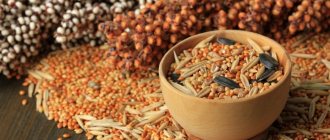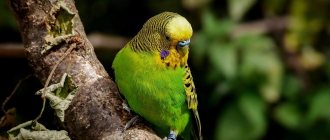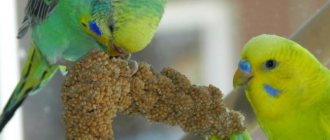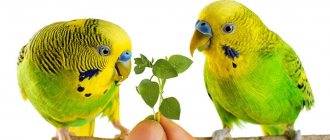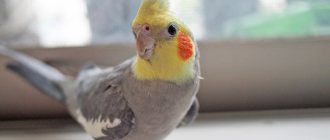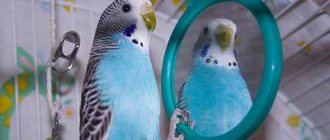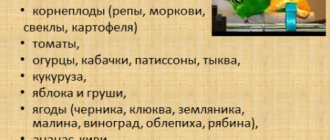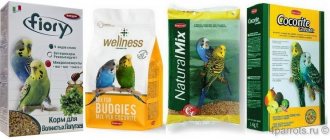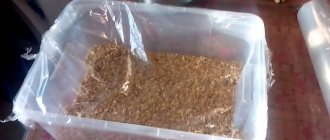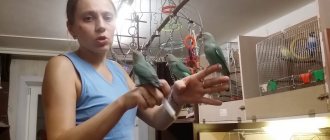Owners of decorative birds know that spikelets of chumiz are the best delicacy for parrots. Experienced poultry farmers always keep appetizing cobs with small grains in stock. A tempting treat helps to establish contact and tame the bird. It is also suitable as a reward for academic success. Let's talk about what chumiza looks like and where it grows, what its beneficial properties are. We learn about the difficulties of purchasing and growing from seeds.
Composition and beneficial properties
| Blitz information | |
| Name and classification | Species - Chumiza Setaria italica Family - Cereals, or Poaceae. |
| Photo | |
| Description | Chumiza is a plant that is classified as a fodder and grain annual green manure. The bush is formed with 8-10 erect stems that reach 2 meters in length. |
| Synonyms | Black rice, capitate millet. |
| Compound | • Water – 12%; • Proteins -16%; • Fats – 4%; • Carbohydrates – 60%; • Cellulose - 4%; • Ash - 4%. Capitate millet contains: - vitamins B, A, E, C, K, PP; - pectins; - antioxidant compounds; - calcium, - selenium, - magnesium, - iron, - silicon, - manganese, - sulfur, - copper, - potassium, - phosphorus, - zinc, - sodium. |
| Cultivation area | • Russia (Far East) • China • Japan • Korea • Mongolia • India • Ukraine • Belarus • Georgia • Kazakhstan |
| Application | There are many types of black rice, which differ in the shape of the ear, the length and color of the grain from which flour is made for animals. It is used for the following purposes: • used for feeding birds; • prevents the growth of weeds, enriches the soil with nitrogen, improves soil structure; • is a source of oil that is used in cosmetology; • is a treat for pet parrots. Feature - chumiza can be fed to all representatives of the Parrot family, regardless of breed, age or size. |
Chumiza
Chumiza is especially useful for parrots, since it has the following properties:
- Increases the body's resistance.
- Strengthens the cardiovascular and musculoskeletal system of birds.
- Promotes normal digestion and metabolism.
- Covers the body's needs for minerals and vitamins.
- It provides sorption protection when toxins enter the body.
- Improves physical activity and mood.
Senegalese millet
Senegalese millet, which is mistakenly confused with chumise, is very popular among parrot breeders. This is also a fodder crop with a similar composition and appearance, but still has its own characteristics. The main difference between Senegalese grain is the lower amount of nutrients. This food is also recommended for birds, and its effect on the body will be the same as that of chumiza, but the benefits from it will still be less.
Useful qualities for birds
Thanks to such a rich composition, black rice surpasses in its benefits almost all cereal crops available to birds. Chumiza has a positive effect on heart function, strengthens blood vessels, improves immunity and normalizes metabolism.
After the breeding season, molting or illness, parrots need a diet rich in vitamins. Chumiza will become an indispensable assistant in the matter of restoring the pet’s body .
The plant protects against the accumulation of heavy metal salts and toxic compounds. This culture gives parrots a boost of activity, improves their mood and receptivity to learning. The plumage becomes smooth and shiny, the beak and claws are maintained in a healthy condition.
In stressful situations, black rice grains have a positive effect on the bird’s nervous system, helping it to cope with this period more easily. When moving, you can also increase the usual dose of the product.
How to give chumiz to parrots
The recommended consumption schedule for parrots is 1 spikelet of chumiza every 3-4 days.
The serving size is no more than 3 spikelets at a time, which are hung around the cage.
Can be used in small doses during training. An increase in volume is allowed during molting, nesting or during the recovery period after illness.
Do not forget that capitate millet should be a tasty addition to the main diet, but not its basis. There will be no harm from it, but birds, carried away by the treat, often begin to refuse other types of food, and accordingly do not receive all the necessary nutrients.
Video Chumiza Treat for budgerigars
How often can you give treats?
When buying plague for birds, you should understand that grain cannot be given every day. It is recommended to study the data on when and how much treats should be fed. Although the product is very healthy, it is not the basis of the diet, but an opportunity to “pamper” the bird. Constant use will lead to abandonment of the main diet.
Experts recommend giving parrots treats 2-3 times a week. To do this, the ear is hung or a separate grain is given. An increase in the norm is acceptable during molting and nesting, since the bird needs more useful elements during these periods.
Seeds are used to encourage an animal during training, taming, or simply as a reward. It is better to hang spikelets so that the birds can get the grain themselves, as in the wild. You can attach them to the cell wall.
Important! You cannot give a whole spikelet, because the parrot will peck and pull at it, knocking down the grains until it eats everything. It is better to hang about a quarter of it.
Where to buy and how to choose
You can buy chumiza in almost every pet store, but it does not always meet the quality criteria.
There are two varieties of capitate millet on the market:
- The highest grade - lush, large ears with large grains - are suitable for constant use.
- The first variety - a small ear with small seeds - is used to introduce this type of nutrition.
When purchasing, you should pay attention to the following nuances:
- there should be no chafing areas or mold;
- the spikelets should not crumble when touched (indicates that the feed is overdried);
- the grains should emit a pleasant herbal smell.
Is there any harm
There is no harm to parrots from regular consumption of chumiz. They can eat grains in any quantity on a regular basis. However, it is not recommended to leave the plant freely available to your pet.
Birds really like the delicacy, so having an alternative in the form of chumiza, soon the bird will completely refuse its usual food . It is difficult to retrain a parrot; it will begin to demand exclusively black rice as food.
Chumiza should not be the basis of the diet; the bird's body needs a more expanded menu.
What is chumiza, and what is this plant used for?
Chumiza, or gomi (botanical name is Italian millet) is one of the oldest food crops. Comes from China. In China and Mongolia it was grown 2700 years BC, in Transcaucasia in the state of Urartu - in the 1st millennium BC (VIII-VII centuries), as evidenced by the results of excavations. And now chumiza is used in many countries of the world. It came to Ukraine at the beginning of the 20th century.
In the former USSR, three varieties were zoned: Moskovskaya 2, Novosibirskaya 1 and Severyanka. In Ukraine, since 2001, the mid-season variety Dneprovsky has been released, suitable for food and feed use. In scientific institutions of Ukraine, work is not being done to create new varieties, although this crop produces high (40-60 c/ha) and stable grain yields suitable for making cereals, which contain 14.2% protein, 6% fat and only 0 .4% fiber.
In millet cereals (millet), these figures are 10.5, 1.3 and 2.4%, respectively. Chumiza flour can be used without adding flour improver. Chumizu is used as food for parrots.
Contraindications for use of the product
Doctors have not recorded any serious side effects from consuming chumiza. The only contraindication is individual intolerance to the ingredient. Most often, all this is triggered by a specific reaction of the human body to gluten.
Side effects in the form of intestinal dysfunction, pain, and poor digestion can be caused by cereal abuse. Rationally introduce chumiza into your diet, following the usual framework of KBZHU. Do not forget to supplement the standard set of proteins, fats and carbohydrates with fiber, vitamins, and mineral components.
What is gluten and why is it dangerous?
Gluten is a gluten, a specific protein that is part of the grain of most cereals. Gluten poses a risk to a certain number of patients. Among them are people who suffer from celiac disease. This is a congenital autoimmune disease. Pathology occurs with a probability of 1:500 to 1:100. Celiac disease is a medical diagnosis that is detected through a biopsy and a special blood test. If you have an illness, it is prohibited to consume foods containing gluten, as they worsen the quality of life and lead to the development of pathogenic symptoms. Celiac disease is diagnosed at an early age, so if your doctor still hasn't told you about the pathology, you are completely healthy and don't have to worry about gluten.
Best materials of the month
- Why you can't go on a diet on your own
- How to keep vegetables and fruits fresh: simple tricks
- How to curb your sweet cravings: 7 unexpected products
- Scientists say youth can be extended
Another contraindication is an allergy to gluten. It can appear in any person and is no different from an allergy to tomatoes, citrus fruits or, for example, pecan nuts. To diagnose an allergy, it is enough to take a blood test for specific antibodies. Recognizing an allergy is quite simple - after consuming gluten, a person experiences unpleasant symptoms such as headache/abdominal pain, intestinal dysfunction, rash formation, and so on.
Gluten intolerance can also develop due to its long-term abundance in the human diet. Scientists have called this secondary or acquired sensitivity to gluten. It can manifest itself in both chronic fatigue and the need for hospitalization to save life. The degree of deterioration of the condition depends on the amount of gluten eaten, the individual characteristics of the patient’s body and the stage of sensitivity.
If after the next portion of Chumiza you feel pain, notice the formation of acne and other uncharacteristic symptoms, consult a doctor immediately. Perhaps your body is sensitive to gluten and needs to be completely eliminated from your diet.
If gluten intolerance is not diagnosed, do not stop yourself from eating gluten-containing products. The main thing is to know when to stop, remember your life expectancy and be healthy!
More fresh and relevant information about health on our Telegram channel. Subscribe: https://t.me/foodandhealthru
We will be grateful if you use the buttons:
general information
Chumiza is an annual plant. Its growing area covers the territories of several Asian countries. The spread of this plant across the lands of hot Asian countries is associated with its characteristic feature. It is not afraid of arid climates and can survive for a long time without moisture, which compares favorably with most other varieties of grain crops.
The yield of this fodder crop is also usually several times higher than that of grain plants. As proof, it is worth giving the following example: one spikelet of chumiza can contain up to 6,000 grains. No other seed crop has such parameters.
The appearance of the plant is no less impressive than the given indicators. This is a two-meter bush formed by approximately 7 stems. Each of the stems is decorated with eye-catching wide leaves. The roots of the bush are a developed system and grow more than 1.5 m deep into the soil.
It is noteworthy that this plant repels weeds. Even the ubiquitous loaches do not appear in areas where chumiza is grown.
What not to give
Not all foods are good for parrots. Birds should not be given:
- parsley, dill and other spices;
- onion and garlic;
- eggplant;
- mango;
- avocado;
- persimmon;
- papaya;
- chocolate;
- nuts in large quantities;
- fresh bread and pastries;
- meat and fish;
- milk and dairy products (except low-fat cottage cheese);
- salted, smoked, sweet, fried and boiled foods from the human table;
- alcohol, coffee.
Some of these products (for example, chocolate) pose a mortal danger to birds, so during walks you need to make sure that the parrot does not steal food that is inappropriate for it from the table.
Description and Application
Chumiza, or gomi (botanical name - Italian millet) is one of the oldest food crops. Originates from China. In China and Mongolia it was grown 2700 years BC, in Transcaucasia in the country of Urartu - in the 1st millennium BC (VIII-VII centuries), as evidenced by the results of excavations. And now chumiza is used in various countries of the world.
In the old USSR there were 3 varieties zoned: Moskovskaya 2, Novosibirskaya 1 and Severyanka. In Ukraine, since 2001, the mid-season variety Dneprovsky has been released, suitable for food and feed use. In scientific institutions of Ukraine, work on the formation of new varieties is not carried out, although this crop supplies high (40–60 c/ha) and constant yields of grain suitable for the production of cereals, which contain 14.2% protein, 6% fat and only 0. .4% fiber.
In millet (millet) cereals, these characteristics are therefore 10.5, 1.3 and 2.4%. Chumiza flour can be used without adding flour improver. Chumizu is used as food for parrots.
Contraindications for use of the product
Doctors have not recorded any serious side effects from consuming chumiza. The only contraindication is individual intolerance to the ingredient. Most often, all this is triggered by a specific reaction of the human body to gluten.
Side effects in the form of intestinal dysfunction, pain, and poor digestion can be caused by cereal abuse. Rationally introduce chumiza into your diet, following the usual framework of KBZHU. Do not forget to supplement the standard set of proteins, fats and carbohydrates with fiber, vitamins, and mineral components.
Acquisition
Despite the fact that chumiza grows mainly in the countries of Southeast Asia, it can also be purchased in a number of other countries. If you need to buy varieties suitable for your pet, then visit your nearest pet store. There you will probably be offered exactly what you are looking for.
As for the assortment, it will certainly be represented by the second and highest grade. For familiarization, it is recommended to take the second grade. Its spikelets are not as large as those of the highest grade. However, even these are suitable for all types of birds.
In addition, there are absolutely no restrictions regarding the types of parrots. Chumiza is suitable for feeding both small budgies and larger birds such as cockatiels.
